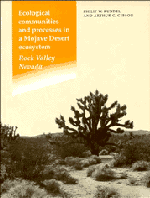Book contents
- Frontmatter
- Contents
- Preface
- Historical prologue on Rock Valley studies
- 1 Introduction to the Mojave Desert
- 2 Physical geography of Rock Valley
- 3 Adaptations of Mojave Desert plants
- 4 Desert perennials of southern Nevada
- 5 Mojave Desert annuals
- 6 Adaptations of Mojave Desert animals
- 7 Mammals
- 8 Reptiles
- 9 Birds
- 10 Arthropods
- 11 Soil organisms and seed reserves
- 12 Nitrogen cycling
- 13 Human impacts on Mojave Desert ecosystems
- References
- Species index
- Main index
13 - Human impacts on Mojave Desert ecosystems
Published online by Cambridge University Press: 19 October 2009
- Frontmatter
- Contents
- Preface
- Historical prologue on Rock Valley studies
- 1 Introduction to the Mojave Desert
- 2 Physical geography of Rock Valley
- 3 Adaptations of Mojave Desert plants
- 4 Desert perennials of southern Nevada
- 5 Mojave Desert annuals
- 6 Adaptations of Mojave Desert animals
- 7 Mammals
- 8 Reptiles
- 9 Birds
- 10 Arthropods
- 11 Soil organisms and seed reserves
- 12 Nitrogen cycling
- 13 Human impacts on Mojave Desert ecosystems
- References
- Species index
- Main index
Summary
Desert ecosystems have in recent times been subjected increasingly to untested contacts with humans and their characteristic activities. Within the past 40 years there has been heavy use of desert scrub communities for recreational purposes, military testing, and construction projects, all of which have modified physical characteristics of soil and altered the composition of desert scrub vegetation and impacted animal populations. Because deserts, by their very definition, receive little annual rainfall, effects from human disturbance can persist for long periods of time, and research has shown that impacts to the ecosystem are extremely long term. Most applied ecological studies in desert regions have been conducted for environmental impact reports, which can access the biological resources at a site relative to undisturbed parcels of desert vegetation, such as at Rock Valley. Such unpublished analyses make recommendations for minimizing impacts of human activities and mitigating what damage is done. There are relatively few articles that describe carefully designed experiments for individual types of human impacts, analyzing short- and long-term effects on desert ecosystems using treatments of differing durations under wet and dry conditions and on various soil types. One goal is to learn which activities forever alter characteristics of natural desert communities versus those that, especially by unaided processes, return a habitat to predisturbance conditions.
SECONDARY PLANT SUCCESSION
Early analyses by desert plant ecologists provided no convincing evidence that plant succession occurred in desert ecosystems (Shreve & Hinckley 1937; Muller 1940; Shreve 1942. Many studies in the Mojave Desert have focused on the topic of secondary plant succession, i.e., recruitment of a new resident plant community following complete removal of shrubs leading to the return of a mature, relatively stable assemblage of of long-lived shrubs (Vasek 1979/80, 1983; Rowlands 1980).
- Type
- Chapter
- Information
- Publisher: Cambridge University PressPrint publication year: 1996



